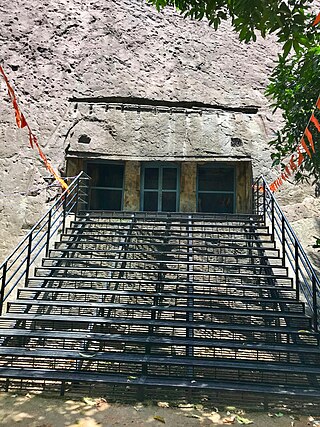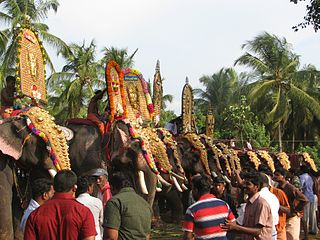
The Archaeological Survey of India (ASI) is an Indian government agency that is responsible for archaeological research and the conservation and preservation of cultural historical monuments in the country. It was founded in 1861 by Alexander Cunningham during the British Raj who also became its first Director-General.

Kunnamkulam is a municipal town situated in the Thrissur District of Kerala in India. Spread over an area of 34.18 km2, it is an old commercial town, with an ancient history. It is famous for its printing and book-binding industry. In the past, the town was called Kunnankulangara and references can be seen many British Archives about a neat and prosperous town which was predominantly Christian. Over the years Kunnamkulam has become a meeting point for all religions.

The Chitharal Jain Monuments and Bhagavati Temple, also known as Chitharal Malai Kovil, Chitaral Cave Temple or Bhagavati Temple, are located near Chitharal village in Kanyakumari district, Tamil Nadu, India. They consist of stone beds with inscriptions, and two monuments – one rock cut Jain temple with outer wall reliefs and one Hindu goddess temple next to it that is a combination of rock-cut and stone that was added during the reign of Vikramaditya Varaguna Pandya. The monuments are from the 9th century CE.

Sittanavasal Cave is a 2nd-century Tamil Śramaṇa complex of caves in Sittanavasal village in Pudukottai district of Tamil Nadu, India. Its name is a distorted form of Sit-tan-na-va-yil, a Tamil word which means "the abode of great saints".

Thirunandikkara Cave Temple, also referred to as Thirunanthikarai rock-cut Shiva temple, is a 9th-century rock-cut Hindu cave temple in Kanyakumari district, Tamil Nadu, India. It is dedicated to Shiva, with murals and inscriptions. It is attributed to the Ay king Vikramaditya Varaguna by Archaeological Survey of India, but to Pandya rulers (Nedunjadaiyan) a few decades earlier by Ajit Kumar, an archaeologist. It is part of a larger active temple complex named the Thirunanthikarai Shri Nandeeswara temple, Thirunanthikarai and is carved out of the side of a rocky hillock to the north of the temple complex. According to Rao, one of the inscriptions suggests that this may be a late 8th-century cave temple or early 9th.

Chermanangad is a small village on the road between Kunnamkulam and Wadakanchery in the Thrissur district of Kerala.

Thrissur is the administrative capital of Thrissur District, in the central part of Kerala state, India. Thrissur district was formed on 1 July 1949. It is an important cultural centre, and is known as the Cultural Capital of Kerala. It is famous for the Thrissur Pooram festival, one of the most colourful and spectacular temple festival of Kerala. From ancient times, Thrissur has been politically, economically and culturally significant to the Indian subcontinent. It has opened the gates for Arabs, Romans, Portuguese, Dutch and English. According to tradition, Thrissur is where Christianity, Islam and Judaism entered the Indian subcontinent. Local Christian tradition holds that Thomas the Apostle arrived in 52 CE, and Muslim tradition states that Methala is the location of country's first mosque.

Hill Palace is an archaeological museum and palace located in the Thrippunithura neighbourhood of Kochi, Kerala. It is the largest archeological museum in the state and was the imperial administrative office and official residence of the Cochin Maharaja. Built in 1865, the palace complex consists of 49 buildings spreading across 54 acres (220,000 m2) and built in the traditional architectural style. The complex has an archaeological museum, a heritage museum, a deer park, a pre-historic park and a children's park.

Trikkur Mahadeva Temple is a rock-cut cave temple in Trikkur village in Thrissur District in Kerala believed to have been built in the 7th or 8th century. Being a cave temple, Buddhist and Jain monks used the site to meditate alongside the Hindu monks. It is a protected monument under the Department of Archaeology, Govt of Kerala since 1966. The temple and its premises are now owned by Paliyam Trust which is managed by Kshetra Samrakshana Samiti.

Archaeological Museum, Thrissur is an art and archaeological museum situated in Thrissur City of Kerala state, India. The museum is located in the Thrissur Zoo compound.

Ariyannur Umbrellas is a prehistoric Megalith burial site situated in Ariyannur in Kandanassery Panchayat of Thrissur District of Kerala. Archaeological Survey of India in 1951 declared it as a centrally protected monument. The site has six umbrella stones or mushroom stones, locally called Kudaikkallu. Of them, four are intact and two are partially broken. .
These are part of the larger Kudakkallu Parambu complex which is believed to be from ~2000 BCE.

Kudakkallu Parambu is a prehistoric Megalith burial site located in Chermanangad of Thrissur District of Kerala. The site has 69 megalithic monuments spread over a small area. Different types of burials in this area include Topikkal, Kudakkal, multiple hood stones and stone circles. The Archaeological Survey of India says that these monuments were built around 2000 BCE. The Archaeological Survey of India has declared it as a centrally protected monument.
Chowannur is a place in Thrissur district, state of Kerala, India.

Eyyal Burial Cave is a prehistoric Megalith rock cut cave situated in Eyyal, of Thrissur District of Kerala. The cave can be accessed from single entry and its chamber is circular. Archaeological Survey of India has declared this cave as centrally protected monument.

Archaeology in India is mainly done under the supervision of the Archaeological Survey of India.

















